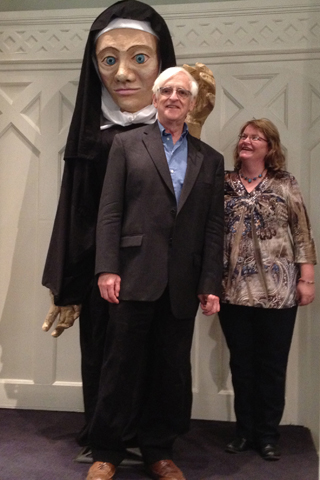
Matthew Fox and Mary Plaster, a former graduate student of Fox's, pose with Plaster's puppet likeness of Hildegard. Plaster brought the puppet to the Call to Action conference in November in Louisville, Ky. The puppet is made from bamboo, bicycle inner tubes and other recycled materials and repurposed fabric. The face and hands are made out of papier-mâché.
Hildegard of Bingen, the 12th-century German mystic and ecologist, didn't have the Hubble Space Telescope or quantum physics at her disposal. She didn't need them. From a young age, Hildegard experienced visions. One of them gifted her with essential information about the beginning of the universe 13.7 billion years ago, when it flared forth from a minuscule speck of energy into a vast fireball.
In his new commentary, Hildegard of Bingen: A Saint for our Times, with a foreword by Joan Chittister, Matthew Fox notes, "curiously, Hildegard writes and draws pictures of what she calls 'fireballs' that enter the human baby when we are born. As she explains, 'A fireball possesses the heart of this child ... the fireball rules the entire body just as the firmament of heavens contains lowly things and covers celestial things and also touches the brain of the person ... the fireball gives the greenness of the heart and veins and all the organs to the entire body as a tree gives sap and greenness to all the branches from its root.' "
Today's science, Fox writes, tells us the original fireball is present in our brain when photons light up with new ideas and in the process of photosynthesis, the greening of the plants. "Thus when we eat plants, fish or other creatures we are ingesting 'fireballs' that are descended from the original fireball."
This is pretty powerful information. With it in mind, consider meditating upon baby Jesus and the fireball greening within his tiny, compassionate heart. Does the image perhaps bring up thoughts of the cosmic Christ, who is present throughout all of time and space?
Fox's book is one of two new works released in October to coincide with Hildegard's being named the fourth woman doctor of the church by Pope Benedict XVI. Illuminations: A Novel of Hildegard von Bingen, by historical novelist Mary Sharratt, is the second. Sharratt's hardback, published by Houghton Mifflin Harcourt, was recently cited by Kirkus Review as one of the outstanding novels of 2012.
If you are searching for particularly lovely Christmas gifts, Fox's and Sharratt's books can serve as great companion pieces. Both deal with Hildegard as a child, given to a Benedictine monastery at age 8 by her family to be trained by Jutta von Sponheim, an abbess just six years her senior.
Both go into aspects of her adult life as a Benedictine abbess, cosmologist, ecologist, herbalist and composer. Both give us good glimpses of her as a nervy prophet who criticized the church corruption of her day but whose writings and visions were validated and supported by Bernard of Clairvaux and Pope Eugenius III.
Much of the material in Fox's book is similar to the thoughts he presented in a 1985 commentary on her mandalas, Illuminations of Hildegard of Bingen. However, in this contemporary collection of essays, Fox has Hildegard meeting with Jesus and the Buddha, Mary Oliver, Howard Thurman, Albert Einstein, Clarissa Pinkola Estes and Dorothee Soelle.
"I wanted to explore some of those teachings that seem most pertinent and pressing for our time -- an era, as we are all aware, of challenge and peril for Mother Earth and her creatures, and for the human race and in efforts in such areas of culture as religion, economics, education and politics," he writes.
Fox says Hildegard continues to visit him through the beauty of nature, "with its aliveness and greening power, its jasmine trees pouring forth their amazing scent, the birds singing their memorable songs, the waters glistening and the ducks coming out for the evening ritual of sunset."
I can identify. In 1991, I had been accepted to study for a master's degree at Fox's Institute in Culture and Creation Spirituality at Holy Names University in Oakland, Calif., but was experiencing difficulties in putting together the financial practicalities. At the same time, I was awash in Hildegard's words, ideas and music. Her saying, "I am a feather on the breath of God," haunted me.
On two occasions, while walking to my then-boring, dead-end marketing job, I meditated on her words. And both times, there in front of me on the asphalt pavement in the grim snowy parking lot rested a humble, large gray feather. Murmuring an astonished "thank you" each time, I placed Hilde's gifts upon my altar. They became talismans of hope.
"Don't give up, Sharon," she spoke through them. Four months later, as the snow melted and the trees blossomed once again, finances resolved themselves and the locked door to the creation spirituality program flew open to herald the best, most creative 18 months of my life.
Sharratt's beautiful novel begins speaking of hope, the hope of a frightened 8-year-old girl that she will be able to return home to her family, her beloved nurse, her home and the forest, where she climbed trees with her favorite older brother and listened to the birds sing.
But it was not to be, at least immediately. Hildegard's hope of seeing the trees and the flowers would take 30 years -- the day Jutta died. Hildegard had been abruptly spirited away from home by her poor, bent, worn-out mother (toothless, with thinning hair caused by having 10 children too close together), to go live in a tiny walled-up hermitage attached to a Benedictine monastery in Disibodenberg. Hildegard was the 10th child and as such, was regarded as the tithe to be given to God. A secondary reason for her banishment was because the child kept having embarrassing visions, one being her ability at age 4 to see the unborn calf in the womb of a cow and to be able to describe what it looked like. When the calf was born, with the exact markings Hildegard had predicted, her mother became very nervous -- this was not normal. What would people say? Was it witchcraft?
After having more visions about lights, off to Disibodenberg went little Hildegard, straight into the care of a 14-year-old abbess named Jutta von Sponheim who would teach her for the next 30 years within the confines of two tiny rooms, where the only opening was a window into the church. No more trees, chirping birds, vibrantly greening grass, cows and visions of unborn calves.
Hildegard's new substitute mother-teacher-mentor was an extreme ascetic who scourged and starved herself in order to emulate Christ's sufferings.
In her afterword to the novel, Sharratt, an American author who lived for 12 years in Germany and now lives in England with her Belgian husband, acknowledges that her version of the opening chapters is based on the writings of Guibert de Gembloux's Vita Sanctae Hildegardis. Gembloux maintained that Hildegard, Jutta and possibly one other young girl were bricked into a mausoleum-like prison.
But another account of Jutta's life, discovered in 1991 and probably written by Volmar, Hildegard's longtime secretary and steadfast friend, says Hildegard spent her childhood at Jutta's family estate of Sponheim and entered the monastery when she was 14 and Jutta was 20. It is also probable that the monastic rooms they occupied did have windows where they could actually look out upon nature.
Sharratt's choice of Gembloux's version makes for some dark, intense chapters, and reading them is often difficult to endure. But the author's excellent narrative style and gift of storytelling lure the reader to persevere to see what will happen next. One is never disappointed. Sharratt's plotline moves well, and the reader becomes a willing and eager traveler. But I would have preferred to find out where Sharratt might have taken her imagination using Volmar's version of Hildegard's early years with Jutta.
The novel, told in the first person, traces Hildegard's life from the time she is 4, taking us into her 80s, near the end of her life.
All of the characters live and breathe, especially Hildegard, Volmar, Jutta and Richardis, Hildegard's beloved friend.
Expect to shed a tear or two. Especially at the end, when Hildegard and her sisters devise a way around a yearlong papal interdict forbidding them to sing because they had buried an apostate in their convent graveyard.



